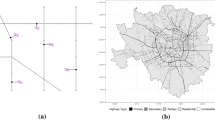Abstract
The concepts of medical geography provide a framework for investigating the importance of people–place interactions in risk analysis and assessing the roles of individual, behavioral, and environmental risk factors. Analyses of data on motor vehicle collisions in Connecticut in 1995 and 1996 are used to illustrate geographical variations in the characteristics of collisions. A method is presented for identifying high frequency collision sites for particular collision types. Proportions and odds ratios calculated as local statistics are used to highlight sites where the individual, behavioral, or environmental characteristics of collisions differ significantly from those in the state as a whole. These differences have implications for developing better statistical models for knowledge synthesis and policy development.





Similar content being viewed by others
References
Ameratunga S, Hijar M, Norton R (2006) Road-traffic injuries: confronting disparities to address a global-health problem. Lancet 367:1533–1540
Berenson RA (2004) Lumpers and splitters: different approaches to understanding variations research. Health Aff 98:VAR98–VAR103
Centers for Disease Control and Prevention (2006a) BRFSS turning information into health. http://www.cdc.gov/brfss/ Centers for Disease Control and Prevention Atlanta
Centers for Disease Control and Prevention (2006b) Environmental public health indicators project. http://www.cdc.gov/hceh/indicators/ Centers for Disease Control and Prevention Atlanta
Chadwick E (1965) Report on the sanitary condition of the labouring population of Great Britain. In: Flynn MW (ed) Edinburgh University Press, Edinburgh
Chen IG, Durbin DR, Elliott MR, Senserrick T, Winston FK (2006) Child passenger injury risk in motor vehicle crashes: a comparison of nighttime and daytime driving by teenage and adult drivers. J Safety Res 37:299–306
Cromley E (2003) Case study of the use of GIS to inventory and understand the pattern of traffic accidents in Connecticut. In: Clarke KC (ed) Getting started with geographic information systems, 4th edn. Prentice-Hall, Upper Saddle River, pp 237–241
Davis JW, Bennink LD, Pepper DR, Parks SN, Lemaster DM, Townsend RN (2006) Aggressive traffic enforcement: a simple and effective injury prevention program. J Trauma Inj Infect Crit Care 60:972–976
Diez-Roux AV (2000) Multilevel analysis in public health research. Annu Rev Public Health 21:171–192
Duncan C, Jones K (2000) Using multilevel models to model heterogeneity: potential and pitfalls. Geogr Anal 35:279–305
Duncan JD (1994) Place. In: Johnston RJ, Gregory D, Smith DM (eds) The dictionary of human geography, 3rd edn. Blackwell, Oxford, p 442
Eisenberg D, Warner KE (2005) Effects of snowfalls on motor vehicle collisions, injuries, and fatalities. Am J Public Health 95:120–124
Fotheringham AS et al (2002) Geographically weighted regression: the analysis of spatially varying relationships. Wiley, Chichester, pp 19, 45, 160–162, 177–179
Gatrell AC (2002) Geographies of health: an introduction. Blackwell, Oxford, p 1
Gilbert EW (1958) Pioneer maps of health and disease in England. Geogr J 124(Part 2):172–183
Goddard N (2002) A review of medical geography in historical perspective. Soc Hist Med 15:173–174
Guerts K, Thomas I, Wets G (2005) Understanding spatial concentrations of road accidents using frequent item sets. Accid Anal Prev 37:787–799
Hallenbeck WH (1993) Quantitative risk assessment for environmental and occupational health, 2nd edn. Lewis Publishers, Boca Raton
Hunter JM (1974) The challenge of medical geography. In: Hunter JM (ed) The geography of health and disease. Department of Geography Studies in Geography No. 6. University of North Carolina, Chapel Hill, pp 1–31
Jenkins R et al (2005) Matters of life and death: the control of uncertainty and the uncertainty of control. In: Steffen V, Jenkins R, Jessen H (eds) Managing uncertainty: ethnographic studies of illness, risk and the struggle for control. Museum Tusculanem Press, Copenhagen, pp 9–29
Johnson SW, Walker J (1996) The Crash Outcome Data Evaluation System (CODES) DOT HS 808 338 National Highway Traffic Safety Administration, Washington DC
Jones K, Duncan C (1996) People and places: the multilevel model as a general framework for the quantitative analysis of geographical data. In: Longley P, Batty M (eds) Spatial analysis: modelling in a GIS environment. Geoinformation International, Cambridge, pp 79–104
Kearns RA (1993) Place and health: toward a reformed medical geography. Prof Geogr 45:139–147
Kim KE, Yamashita EY (2001) Asleep at the wheel: spatial and temporal patterns of fatigue-related crashes in Honolulu. Transp Res Rec 1779:46–53
Krieger N et al (2002) Zip code caveat: bias due to spatiotemporal mismatches between zip codes and U.S. Census-defined geographic areas—the Public Health Disparities Geocoding Project. Am J Public Health 92:1100–1102
LaScala EA, Gruenewald PJ, Johnson FW (2004) An ecological study of the locations of schools and child pedestrian injury collisions. Accid Anal Prev 36:569–576
Massie DL, Green PE, Campbell KL (1997) Crash involvement rates by driver gender and the role of average annual mileage. Accid Anal Prev 29:675–685
National Center for Statistics and Analysis (2006) Traffic safety facts 2004 DOT HS 809 919. National Highway Traffic Safety Administration, Washington DC, pp 142–143
Price B, Ware A (2005) Mesothelioma: risk apportionment among asbestos exposure sources. Risk Anal 25:937–943
Richter ED, Berman T, Friedman L, Ben-David G (2006) Speed, road injury, and public health. Annu Rev Public Health 27:125–152
Robinson AH (1982) Early thematic mapping in the history of cartography. University of Chicago Press, Chicago
Rothman KJ (2002) Epidemiology: an introduction. Oxford University Press, Oxford, pp 76–77, 86
Rupke, NA (ed) (2000) Medical geography in historical perspective. In: Medical History Supplement No. 20. Wellcome, London
Rushton G, Lolonis P (1996) Exploratory spatial anlaysis of birth defect rates in an urban population. Stat Med 15:717–726
Shannon GW (1981) Disease mapping and early theories of yellow fever. Prof Geogr 33:221–227
Spjtvøll E (1987) Probability: interpretation and estimation. In: Singleton WT, Hovden J (eds) Risk and decisions. Wiley, Chichester, pp 13–24
Sterling TD (1978) Does smoking kill workers or working kill smokers? or the mutual relationships between smoking, occupation, and respiratory disease. Int J Health Serv 8:437–452
Subramanian R (2006) Motor vehicle traffic crashes as a leading cause of death in the United States, 2003. Traffic safety facts research note DOT HS 810 568. National Highway Traffic Safety Administration, Washington DC
Woodward WA, Huang EH, McNeese MD, Perkins GH, Tucker SL, Strom EA, Middleton L, Hahn K, Hortobagyi GN, Buchholz TA (2006) African–American race is associated with a poorer overall survival rate for breast cancer patients treated with mastectomy and doxorubicin-based chemotherapy. Cancer 107:2662–2668
Author information
Authors and Affiliations
Corresponding author
Rights and permissions
About this article
Cite this article
Cromley, E.K. Risk factors contributing to motor vehicle collisions in an environment of uncertainty. Stoch Environ Res Risk Assess 21, 473–486 (2007). https://doi.org/10.1007/s00477-007-0130-5
Published:
Issue Date:
DOI: https://doi.org/10.1007/s00477-007-0130-5




